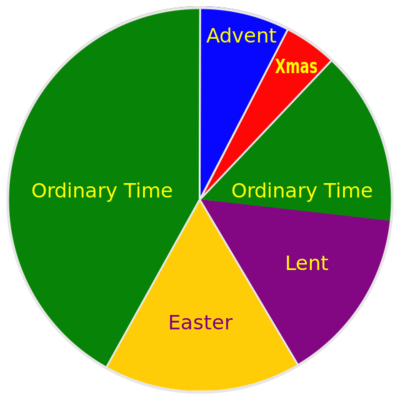Christmas season: Difference between revisions
No edit summary |
|||
| Line 68: | Line 68: | ||
== Historical roots == | == Historical roots == | ||
* Roman feast of Sol Invictus, "The Unconquerable Sun." The pun on "Sun/Son" does not exist in Latin, where the two words are "filius" and "sol." | * It seems that the birth of Jesus was not celebrated as a separate feast until the 4th century or so. The East has preserved an earlier tradition linking the birthday of Jesus with the [[Baptism of the Lord]] (Theophany, January 6--see [[Epiphany]]). | ||
* ''Natalis Solis Invicti'': Roman feast of ''Sol Invictus'', "The Unconquerable Sun." The pun on "Sun/Son" does not exist in Latin, where the two words are "filius" and "sol." | |||
* Saturnalia. | * Saturnalia. | ||
* March 25-->December 25. | * March 25-->December 25. | ||
"Because of the differences in calendars in use at that time, the Eastern Church celebrated the Incarnation on what is January 6 on our western calendars (although on their calendars this corresponded to December 24), also as an alternative to pagan solstice festivals. Today, most of the Eastern churches (with the exception of Russian Orthodox) follow the Western practice of celebrating Christmas on December 25. However the Western churches also adopted the January 6 date and used it to observe what is now called Epiphany. In effect, the Eastern churches adopted December 25th from the West and the western churches adopted January 6 from the East, and now both are observed in both traditions, although with different emphases."[http://www.crivoice.org/cyxmas.html] | |||
== Modern controversies == | == Modern controversies == | ||
Revision as of 04:58, 7 January 2011

The Christmas season lasts from Christmas Day until the Feast of the Baptism of the Lord.
| December 25 | Christmas Day |
| January 1 | Octave of Christmas; Solemnity of Mary Mother of God |
| December 25 - January 5 | Twelve Days of Christmas |
| January 6 | Epiphany |
| Sunday after Epiphany | Baptism of the Lord |
| 25 December | 1 |
| 26 | 2 |
| 27 | 3 |
| 28 | 4 |
| 29 | 5 |
| 30 | 6 |
| 31 | 7 |
| 1 January | 8 |
| 2 | 9 |
| 3 | 10 |
| 4 | 11 |
| 5 | 12 |
Xmas
The first letter of this ancient abbreviation is not the English character "X" but the Greek character Chi. It is the first letter of "Christos" in Greek: Χριστος. People who use this abbreviation (as I did in the pie chart of the liturgical year) are not "Xing" Christ out of Christmas; they are going back to the original language of the New Testament and to the earliest days of Christianity to find a convenient symbol for Christ.
This is an example of the problems associated with transliteration.
Historical roots
- It seems that the birth of Jesus was not celebrated as a separate feast until the 4th century or so. The East has preserved an earlier tradition linking the birthday of Jesus with the Baptism of the Lord (Theophany, January 6--see Epiphany).
- Natalis Solis Invicti: Roman feast of Sol Invictus, "The Unconquerable Sun." The pun on "Sun/Son" does not exist in Latin, where the two words are "filius" and "sol."
- Saturnalia.
- March 25-->December 25.
"Because of the differences in calendars in use at that time, the Eastern Church celebrated the Incarnation on what is January 6 on our western calendars (although on their calendars this corresponded to December 24), also as an alternative to pagan solstice festivals. Today, most of the Eastern churches (with the exception of Russian Orthodox) follow the Western practice of celebrating Christmas on December 25. However the Western churches also adopted the January 6 date and used it to observe what is now called Epiphany. In effect, the Eastern churches adopted December 25th from the West and the western churches adopted January 6 from the East, and now both are observed in both traditions, although with different emphases."[1]
Modern controversies
Christmas and Easter are traditional feasts when lapsed Catholics make a guest appearance at Mass. We hope and pray that they will "come to Church for a change."